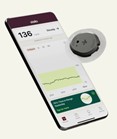Peer Reviewed
In March 2024, the FDA announced that it had cleared Dexcom Stelo, the first over-the-counter continuous glucose monitoring (CGM) system for adults without diabetes who want to understand better how diet and exercise affect their health (Figure 1). Three months later, the FDA cleared Abbott Lingo, another CGM specifically targeted at consumers without diabetes who want to learn about and manage their glucose levels. CGMs like Stelo and Lingo consist of a biosensor typically inserted in the back of the arm. The sensor connects to a smartphone application, where users can track their interstitial glucose level in real time. Many studies have shown that CGMs can help reduce glycated hemoglobin levels in type 1 diabetes and insulin-treated type 2 diabetes.1-3 Is there any evidence that suggests that CGMs could help improve the health of adults without diabetes?
Skeptics argue that having more knowledge about your glucose levels does not necessarily translate to health benefits. For example, drops in blood sugar could lead some users to eat more, leading to weight gain and increased risk of developing diabetes. Proponents of CGMs assert that by providing real-time data, CGMs offer valuable education to users on how lifestyle affects their health. The implication is that this knowledge will lead users to exercise more and choose healthy, low-calorie diets that will result in weight loss and diabetes prevention. Reviewing the evidence for the effectiveness of CGMs thus requires assessing 1) whether CGMs lead to behavior modification, and 2) whether those behavioral changes are truly beneficial.
Currently, there is no evidence from a large randomized controlled trial (RCT) that specifically addresses how CGMs help modify diet and exercise in adults without diabetes. One of the primary challenges with conducting such a study is precisely tracking the food that participants eat and how much they exercise. However, data from patients with type 2 diabetes suggest that CGMs do lead to a significant increase in exercise compared to self-monitoring: after 3 months, participants with a CGM averaged 346 minutes of weekly exercise, compared to 235 minutes in participants who self-monitored.4 Notably, CGM use did not result in a difference in total calorie intake, fat consumption, or cholesterol intake compared to self-monitoring.
If CGMs could be shown to lead to appropriate lifestyle changes, then we could be reasonably confident that they would help reduce diabetes risk. Â The landmark Diabetes Prevention Program RCT, published in the New England Journal of Medicine in 2002, showed that lifestyle intervention was more effective than metformin at reducing the incidence of diabetes in people at high risk.5 Beneficial lifestyle changes in the intervention group include weight reduction of 7% of initial body weight through a low-calorie, low-fat diet and exercise for at least 150 minutes per week.
Based on the available evidence, it is likely that a CGM paired with appropriate changes in diet and exercise will improve health in adults without diabetes. Long-term studies showing that CGM use decreases the incidence of diabetes in healthy adults are needed to establish the benefit of CGMs firmly.
By James Sun is a medical student at NYU Grossman School of Medicine
Reviewed by Michael Tanner, MD, Executive Editor, Clinical Correlations
References
- Juvenile Diabetes Research Foundation Continuous Glucose Monitoring Study Group, Tamborlane WV, Beck RW, Bode BW, et al. Continuous glucose monitoring and intensive treatment of type 1 diabetes. N Engl J Med. 2008;359(14):1464-1476. doi:10.1056/NEJMoa0805017
- Beck RW, Riddlesworth TD, Ruedy K, et al. Continuous glucose monitoring versus usual care in patients with type 2 diabetes receiving multiple daily insulin injections: a randomized trial. Ann Intern Med. 2017;167(6):365-374. doi:10.7326/M16-2855
- Wada E, Onoue T, Kobayashi T, et al. Flash glucose monitoring helps achieve better glycemic control than conventional self-monitoring of blood glucose in non-insulin-treated type 2 diabetes: a randomized controlled trial. BMJ Open Diabetes Res Care. 2020;8(1):e001115. doi:10.1136/bmjdrc-2019-001115
- Yoo HJ, An HG, Park SY, et al. Use of a real time continuous glucose monitoring system as a motivational device for poorly controlled type 2 diabetes. Diabetes Res Clin Pract. 2008;82(1):73-79. doi:10.1016/j.diabres.2008.06.015
- Knowler WC, Barrett-Connor E, Fowler SE, et al; Diabetes Prevention Program Research Group. Reduction in the incidence of type 2 diabetes with lifestyle intervention or metformin. N Engl J Med. 2002;346(6):393-403. doi:10.1056/NEJMoa012512

